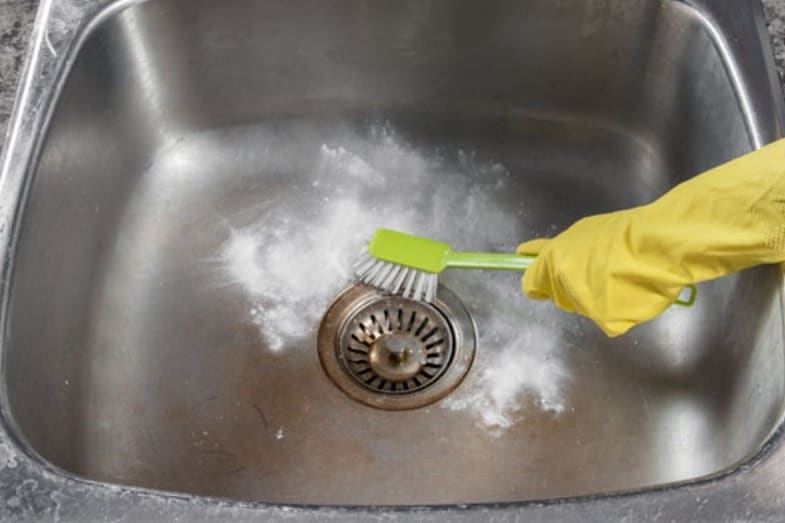What is the best way to clean a stainless steel sink? Stainless steel does not crack, chip, or peel, and it is resistant to stains. However, it is still important to clean stainless steel regularly. In this article, I will describe the best way to clean your stainless sink.
How to clean a stainless steel sink? To clean your stainless steel sink, follow these 9 easy steps:
- Get the Cleaning Materials
- Clear the Sink
- Clean the Sink Strainer
- Clean the Drain
- Sprinkle Baking Soda in the Sink
- Scrub the Sink
- Pour Vinegar in the Sink and Rinse
- Dry the Sink
- Shine the Sink
You can perform these steps each week or every second week to deep clean your stainless steel sink. To maintain the cleanliness of your sink, avoid leaving dirty dishes and food scraps in the sink. After washing your dishes, give a quick wipe down of the sink walls with liquid soap and a cloth.
Read on to learn more about the best way to clean a stainless steel sink, including cleaning the drain and maintaining its cleanliness all year.
Also, take a look at an excellent stainless steel cleaner, the Weiman Stainless Steel Cleaner and Polish. This cleaner is strong and does an easy job of cleaning your stainless steel sink.
Click here to see it on Amazon.
Best Way to Clean a Stainless Steel Sink
There is no argument that stainless steel is the most preferred material for kitchenware and fixtures because of its strength, resiliency, and durability. However, it can become a feeding ground for illness-causing bacteria.
Cleaning your stainless steel sink is easy. Simply follow the 9 sink-cleaning steps below to make your sink look new again.
1. Get the Cleaning Materials
Prepare baking soda, white vinegar, a sponge or cloth, a pair of gloves, and optional club soda or olive oil for extra shine.
Also, if you plan on cleaning your drain, include a plunger or an auger and a drain cleaner. However, since cleaning the drain takes some extra time, you can clean it separately, so you can concentrate more on cleaning the sink.
Before starting your task, you must have all these materials beside you and not be going around finding other missing things. Sometimes, we fail to prepare the materials we need, making the task more difficult and cumbersome. Thus, preparation is the key to perform the task well.
2. Clear the Sink
It should go without saying that before cleaning the sink, you should clear it of all clutter and food scraps. Quite often, plates, utensils, and glasses are left in the sink after eating. Wash and remove all of those from the sink.
Also, remove any food scraps, especially any residue stuck in the sink strainer. After removing all the clutter, splash the sink with some running water to remove any tiny bits of food or debris.
3. Clean the Sink Strainer
If your sink has a removable sink strainer, take it out and make sure it is free from residue. Food scraps and other waste ends up in the drain. If you fail to clean the sink strainer, it may clog later.
It’s important to clear the drain strainer from obstacles, such as food scraps and residue, to have a smoother flow of water down the drain.
4. Clean the Drain
Although the whole drain is not part of the sink, once clogged, it affects the sink basin and damages it. So, it is also essential to take care of the sink drain to ensure the smooth flow of wastewater from the sink.
You can clean the drain later; however, it is ideal to clean it first before you clean the sink as food debris from the drain could come up into the sink.
Remove the sink strainer and then put a cup of baking soda down the drain. Next, pour a cup of vinegar and put the strainer back to cover it. You can also use a cloth to cover it.
Baking soda and vinegar are two of the most famous natural cleaners. They both can break up stains, grout, and food residue. They are also natural deodorizers, so they help get rid of any odors coming from within the pipe. When you combine the two ingredients, you will see it foam and bubble up.
When baking soda and vinegar are mixed, the hydrogen ions in the vinegar mix with the sodium and ions in the baking soda.
This reaction results in two new chemicals: carbonic acid and sodium acetate. The second reaction is decomposition. The carbonic acid decomposes into carbon dioxide gas and water.
The carbon dioxide rises to the top (like bubbles in a soda). This creates the foam and bubbles you see when you mix vinegar and baking soda.
It’s best to let this baking soda and vinegar mixture sit in the drain for a few minutes or up to 30 minutes.
While letting it soak, boil some water and pour as much boiling water down the drain as you can. Flushing hot water from the tap down the drain is fine, but boiling water is more effective at loosening up reside in the drain.
Baking soda and vinegar work great, but there are even stronger drain cleaners such as the Liquid-Plumr 128 oz Full Clog Destroyer Pro-Strength.
Click here to see it on Amazon.
The Liquid-Plumr has a powerful, triple-action formula that can easily break up full clogs. It will also keep pipes clog-free with its protective PipeGuard technology – a repellent barrier that prevents grime from sticking to the walls of the pipe.
If your sink is clogged, fill the sink with water, put a plunger on the drain opening, and pump it several times. Remove the plunger and check whether the wastewater can flow freely. If it does, then the clog is successfully removed. If the plunger doesn’t work, try using an auger. It’s effective at breaking up clogs deeply embedded inside the unreachable part of the drain.
5. Sprinkle Baking Soda in the Sink
Put the sink strainer back in the drain so that it will be cleaned along with the sink. Sprinkle baking soda thinly and evenly on the surface of your sink, including the walls. Make sure to cover every inch of your stainless steel sink.
As mentioned earlier, baking soda is great for removing grime and stains. It is abrasive, which gives it the grit to loosen up particles from the sink. It is also a natural odor-remover or deodorizer – which is very useful when cleaning your stainless sink.
6. Scrub the Sink
Get a brush or scrub pad to scrub the sink. I am a big fan of Scotch-Brite Dobie Scouring Pads. These pads are non-abrasive and the best to use when rubbing baking soda on a stainless steel sink, as they won’t scratch the surface.
Click here to see it on Amazon.
Even though baking soda is abrasive, it isn’t abrasive enough to scratch your stainless steel sink. So you can use it without worry. However, a brush with hard bristles might scratch it, so I recommend the Dobie pads for scrubbing your sink.

7. Pour Vinegar in the Sink and Rinse
When you are done scrubbing the baking soda, pour white vinegar over it. Again, the chemical reaction will occur in mixing the vinegar and baking soda. Together, they will remove odors and help eliminate illness-causing bacteria.
Next, splash water again on the sink to remove both the baking soda and vinegar. Make sure to rinse all the corners of the sink as well.
If there is any stubborn rust in the sink, use a steel rust-remover, such as the CitriSurf 77 Plus Stainless Steel Rust Remover. This rust-remover is excellent in keeping stainless steel sink surfaces free from rust stains and preventing further corrosion.
Click here to see it on Amazon.
8. Dry the Sink
Using a clean cloth, wipe the sink dry. See to it that you dry every corner of the sink before finishing up. Even though stainless steel is durable, if you leave the sink with water on it, it could form stains and discoloration.
9. Shine the Sink
An optional final step to cleaning your stainless steel sink is to wipe it down with club soda for extra sparkle. After drying the sink in the last step, it will be clean, but it won’t have a sparkle like when it was brand new.
Simply pour some club soda on a clean rag and wipe down the inside of the sink. Another trick to making the sink shine is to rub the skin of a lemon or orange peel against all parts of the stainless steel sink.
You can also apply a few drops of olive oil to a microfiber cloth and buff the sink until it sparkles. By now, your sink should look brand new again.
For an even greater luster, you can use a commercial stainless steel cleaner such as the Weiman Stainless Steel Cleaner and Polish:
Click here to view this cleaner on Amazon.
This cleaning product is manufactured specifically for stainless steel appliances. It has a powerful formula that will eliminate stains from the sink with ease and leave your sink shiny. Put enough of this cleaner on a clean sponge and wipe your stainless steel sink until it sparkles.
That is how you clean a stainless steel sink effectively. However, you also need to treat your sink daily, and it doesn’t have to be all the steps. Just wipe your sink with a dry cloth and make sure there are no food scraps on the strainer to prevent corrosion.
It’s also a good habit to always remove dirty dishes and utensils from the sink so that the food and odor left on them won’t transmit bacteria to the sink.
Other Tips for Maintaining Your Stainless Steel Sink
- Avoid Leaving Items in the Sink for Prolonged a Period – As mentioned, don’t leave sponges, rags, soap, cooking pans, and iron cookware in your sink for prolonged periods. Letting iron cookware stay on the sink promotes the formation of stain and rust. Leaving wet sponges, rags, and soap on the sink also reduces the radiance of the stainless steel sink, making it look dull.
- Refrain from Using Your Sink as Chopping Board – Sometimes, you forget and use your sink as a chopping board. When you use it as such, you tend to scratch the surface of your stainless steel sink.
- Avoid Using Steel Wool – Using steel wool to clean your stainless steel sink is a big NO. Particles of the iron steel wool may be left on the sink and can cause corrosion.
- Establish a Routine Cleaning Regimen – Your stainless steel sink must be cleaned regularly since most tap water contains chlorine.
- Be Mindful of the Grain Direction – When cleaning your stainless steel sink, always follow its grain direction to ensure that the crevices are cleaned without any residue. Being mindful of the grain direction will guarantee that no corrosion-causing particles are left behind in your sink.
- Always Keep the Sink Dry – Your sink must be kept dry after use to maintain its luster. So, dry your sink immediately to avoid having a dull-looking stainless steel sink.
See the below video for other great tips on cleaning your stainless steel sink:
Conclusion – Best Way to Clean a Stainless Steel Sink
So, to recap, what is the best way to clean a stainless steel sink? To clean your stainless steel sink, follow the 9 easy steps below:
- Get the Cleaning Materials
- Clear the Sink
- Clean the Sink Strainer
- Clean the Drain
- Sprinkle Baking Soda in the Sink
- Scrub the Sink
- Pour Vinegar in the Sink and Rinse
- Dry the Sink
- Shine the Sink
You can perform these steps once a week or every second week to deep clean your stainless steel sink. Each day, remember to avoid leaving dirty dishes and food scraps in the sink.
Also, after washing your dishes, quickly wipe down the sink walls with a clean cloth and liquid soap. Doing this will maintain the cleanliness of your sink so that it looks fresh, clean, and brand new all year.
Related reading:
Best Way to Clean Walls – 7 Easy Steps
Best Way to Clean a Dishwasher – 6 Easy Steps













![Read more about the article Kerosene Heater for Garage [Best Picks and Tips]](https://homecarezen.com/wp-content/uploads/2021/11/kerosene-heater-for-garage-300x200.jpg)